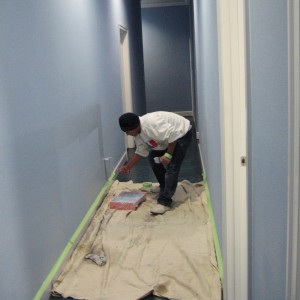 Preparing the Room
Preparing the Room
While painting might seem fun, preparing all necessary aspects before you start painting is the most time-consuming part. You need to cover the edges of your hardware store with a masking tape or blue take to ensure that you keep the paint off the doors and windows and achieve clean lines. You just cover the parts not to be painted especially the line is not perfect.
You will then proceed to move all furniture to the center of the room, which mostly consists of the heavy furniture. Small and light furniture can be placed outside to create form space for mobility. Cover the furniture to protect them from the at times common splatters of paint.
You will need to cover the floor with a canvas or plastic, the latter been a better option as opposed to the canvas that can absorb paint if the spills are of a large volume. A plastic cover it is made from a non-absorbent material thus able to prevent seepage of large amounts of spilt paint.
Once the room is covered, you can shift your focus to the walls, removing all wall hangings. Patch up all holes and ensure you clean the wall. Do not opt to cover the holes with paint; it will give an unsightly finish. Sue the right patching agent and follow the directions as instructed on the patch kit. Let the patching dry before you start painting the walls.
The Necessary Equipment
- Wall Paint
- Blue tape/masking tape
- Paintable Straight Edge
- Plastic or canvas tarp
- Paint rollers
- Furniture coverings
- Wet towels for cleaning up
- Patch kit
- Paintbrushes
- Paint rollers
- Roller pans
- Old clothes
- Extendable ladder for high places
- A pry bar, usually comes with the paint can
Types of Paint
Walls with a dark color of full of patched holes will first need a coat of primer paint. The primer conceals the flaw thus reducing the need for many coats of paint. You can tint the primer if you desire to use darker paint colors.
The available paint options are oil based and latex paints. The latex paint offers more perks than the oil based paint; it is easy to clean using water, has fewer fumes, and more durable. Remember to use interior house paints for indoor painting.
Also, you need to know of the three classifications of paint, which are high gloss, semi-gloss, and flat paints. The three define the type of paint finish (shine) you will achieve on the walls. High gloss has a notable shine, the semi-gloss has moderate shine (a happy medium), and the flat paint has no shine.
Painting the Walls
You can start with either cutting in or the wall itself. Cutting in is a term used to refer to painting all areas that cannot be covered by a roller. You can use a straight edge when paint the edges at the ceiling, windows, doors, and floors. It will help prevent painting the unwanted surfaces and help achieve a clean straight line. Use the right amount of paint on the brush, too much paint cause lots of drips. Wipe off the excess paint using the edge of the paint can before painting.
A roller will make the painting job easy and quick. Work using a W shape, overlapping the paint unit you cover the entire surface. Never let the roller dry when painting, refill it as needed. The entire process is fast and the results are less complicated and with a clean finish.
Wall paint designs and textured paints are a good choice if you are seeking to give the wall a different look. Wall paint designs are more often than note made from homemade stencils that can prove to be time-consuming and tedious, but still give a nice touch of décor to the walls. Textured paint helps to hide painting flaws and is achievable using different textured rollers to create the desired effects. So, keep in mind the two wall painting décor options before you start painting.
Painting can be a fun project for a DIY beginner that can also offer a sense of achievement. It has visual and inspiring impact to all you step into the house.
